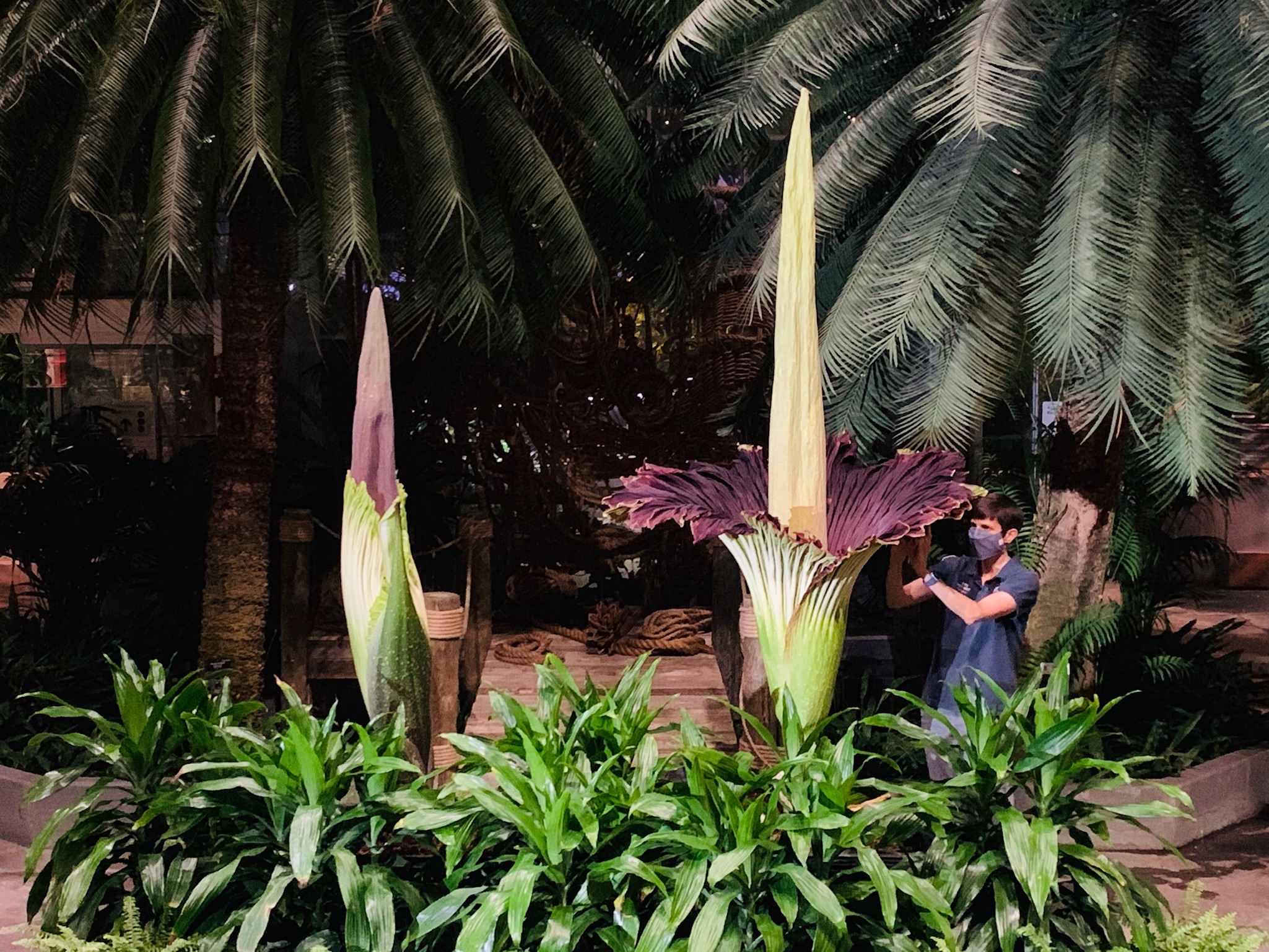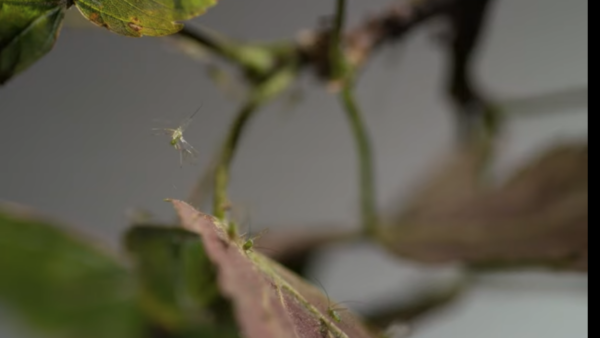A look at the stinkiest, and among the most stunning, plants in the world.
For some reason, and thankfully in a year that the public could visit, 2021 was a banner year for corpse flower blooms across the U.S.
They flowered at Temple University in Pa., the Huntington Library, Art Collections and Botanical Gardens and San Diego Botanic Garden in Cali., the New York Botanic Garden, the U.S. Botanical Gardens in Washington, D.C., and at the University of Tennessee Knoxville (UT Knoxville). A nursery owner even displayed his own corpse flower at an abandoned gas station in Alameda, Cali., for the public to freely enjoy. A banner year indeed for a species that has only successfully flowered outside of its native habitat some 100 times, according to the International Union for the Conservation of Nature.
Rotty Top, Jack Smellington and Stankosaurus Rex are some of the names given to this year’s bloomers. To get to know this plant, let’s first take a look at the Rotty Top’s adventure in July 2021, at the UT Knoxville.
On blooming day, Rotty Top was located behind a locked door on the fourth floor of its home building on campus.
“When I walked in on the first floor, I was immediately hit with the stench,” says Jeff Martin, manager of the university’s Ecology and Evolutionary Biology Greenhouses. “It was a mix of sulfur/garlic, rotting flesh, and different stages of decomposition, like a four to five-day-old dead mouse. The blooms last less than 48 hours and the smell was the strongest for about 12 hours.”
Martin explains that in the native habitat of the corpse flower in the rainforests of western Sumatra, there would be many plants blooming around the same time, and the animals/insects would be the vehicle for the pollen to travel one plant to the other.
“Think decomposers and night pollination, insects that lay eggs in rotting meat, beetles, flesh flies,” he says.
Pollination and Smell
The corpse flower is a sexually-reproducing plant and obviously can’t move around to find a mate, so it must rely on wind and other organisms to spread pollen. Many plants attract pollinators with strong scents, but in the case of the corpse flower (scientific name Amorphophallus titanium, literally ‘misshapen giant phallus’), it cannot be called anything but a stench.
In a recent blog entry for the Chicago Botanic Garden titled About That Smell, the garden’s Outdoor Floriculturist Tim Pollak explains the stinky chemicals include dimethyl trisulfide (also emitted by limburger cheese) and dimethyl disulfide (similar to garlic). There’s also a lovely note of trimethylamine (also found in rotting fish or ammonia), as well as isovaleric acid (sweaty footwear smell) and indole (similar to mothballs).
A few days before bloom, the corpse flower plant sends up a spike, called a spadix, which can grow to 12 feet tall in the wild. At bloom, the outer covering, called a spathe, opens to reveal a deep purple interior, and it’s at that point the reek is emitted. To ensure that stench makes it as far as possible in the dense rainforest environment, the plant uses energy it’s stored up in an underground stem called a corm, to generate heat upwards of 90¬∞F.
If pollinated, the spadix is transformed into a large club-like head of orange-red seeds, dispersed in the wild by birds such as the Rhinoceros hornbills and other animals.
Viewing and Smelling
Martin and his colleagues decided to place Rotty Top in a certain office because it’s near the main door to the building and has glass wall panels on two sides for good viewing.
“We provided supplemental light and placed a humidifier in the area,” says Martin. “It was also enough room to setup a time-lapse camera.”
Viewing the corpse flower in person is obviously a rare and interesting experience.
“We love that this plant interests and excites the public,” says Devin Dotson, public affairs specialist at the U.S. Botanical Gardens (USBG) in Washington, D.C. “We’ve seen consistent high interest in viewing our many corpse flower blooms through the years, whether in person, through online educational programs or through live web cams that we’ve set up.”
The USBG has also displayed blooming corpse flowers in 2003, 2005, 2007, 2010, 2013, 2016, 2017 (three blooms) and 2020 (two blooms).
And when you consider the amount of energy that must go into the production of the chemicals and heat during flowering, it’s really no wonder then that these plants only bloom every few years or even once a decade. In fact, the one at UT Knoxville hadn’t flowered since at least 1999.
However, in terms of what’s the most important factor in getting blooming to occur, daylength, temperature, fertility, neither the USBG horticulture team nor others they’ve spoken with have been able to identify a specific element that’s able to trigger a bloom, says Dotson.
“Instead, the USBG team focuses on consistent high heat and high humidity the plant requires for healthy growth and adding energy into its corm,” he says.
Enough pot size for the corm to enlarge is critical. The corpse plant has the world’s largest known corm, sometimes weighing up to 220 lbs. After Rotty Top flowered, Martin and his colleagues remove the corm from the pot and measured the diameter, then multiplied that number by 2.5 for the next pot size. The leaves can be 13 feet wide.
UT Knoxville has three other corpse flowers and recently donated one to the Knoxville Zoo for their new exhibit. Another two may bloom within in the next three years.
Ensure the Plant’s Future
Of course, diversity amongst the gene pool is important for successful conservation of any endangered plant or animal held in conservation collections. There are roughly 500 specimens of this plant in botanical gardens, university and private collections, and all of them are closely related to each other.
In 2018, the USGB helped organize a conference in partnership with Botanic Garden Conservation International on conservation of rare plants that was attended by botanic garden professionals from around the world. Afterwards, the Tools and Resources for Endangered and Exceptional Plant Species (TREES) program was launched in 2019. Now, many botanic gardens are participating in a national corpse flower plant conservation project working on genetic analysis so that they can be deliberate with breeding for genetic diversity purposes.
It’s also challenging that this plant, like many others in the TREES program, produces recalcitrant seeds which are difficult to store; they’re killed by the typical seed preservation methods of drying and freezing.
However, it’s hopeful that more corpse flower plants than ever held in collections around the globe are being supported to bloom, and the public attention each plant receives may help aid in the conservation of natural habitat.











